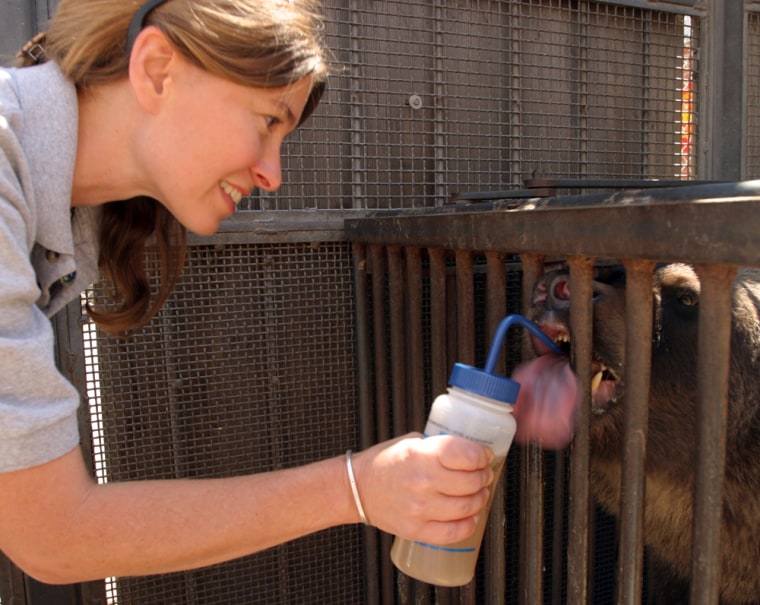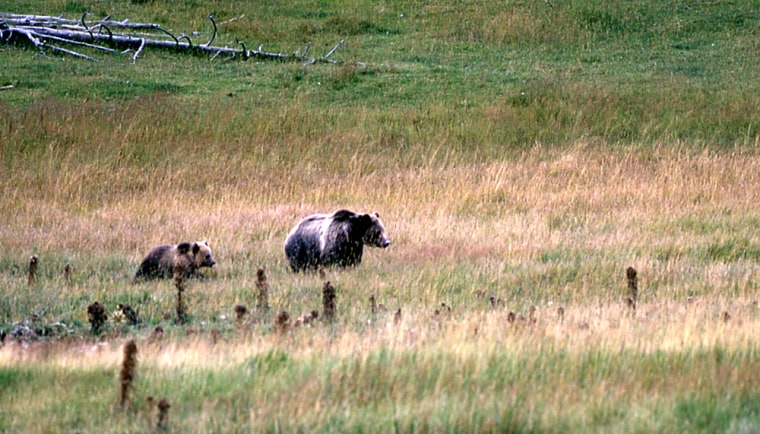A proposal to drop endangered species protections for Yellowstone’s grizzly bears has triggered growls of disagreement among environmentalists and scientists over what is best for the future of the species.
On one side are the federal and state officials charged with managing and protecting the bears. They say that 30 years of protection under the Endangered Species Act has allowed Yellowstone’s grizzly population to triple and thrive, and it’s time to move on. They’re backed by a huge wildlife conservation group that says the very act of taking the Yellowstone bears off the threatened species list will redirect attention and resources to areas where grizzlies remain endangered.
On the other side are marquee environmental groups who admit that a lot of progress has been made in saving Yellowstone’s grizzly population but say the plan to delist the bears is premature and does not contain necessary safeguards.
“Environmentalists are a tricky lot, aren’t we?” says Nina Fascione of Defenders of Wildlife, a group that hasn’t yet taken a position on the proposal.
Grizzlies, who go by the scientific name of Ursus arctos horribilis, number more than 50,000 between Alaska and Canada. They roamed the lower 48 states by the tens of thousands in the days of Lewis and Clark. Now, however, they dwell in just 1 or 2 percent of their previous range there, totaling perhaps 1,200. In addition to the Yellowstone population, there are much smaller groups of grizzlies in five other areas in Idaho, Montana, Wyoming and Washington.
The delisting proposal covers only the bears in the Yellowstone area. If the grizzlies are taken off the threatened species list, it would no longer be against federal law to "harass, harm, pursue, hunt, shoot, wound, kill, trap, capture, or collect" them. It would be up to the states to regulate "taking" of grizzlies, which could include hunting. And, since human-bear conflicts are the biggest cause of death for grizzlies, among the slowest reproducing mammals on the planet, opponents of delisting worry that removal of federal prohibitions on killing them could open the door to many more "self-defense" killings by ranchers, who lose livestock to bears, and other private property owners.
Everybody has an expert
Both sides in the delisting debate bring an army of scientists and bear researchers. One of the foremost in arguing for delisting of the Yellowstone grizzlies is Dr. Chris Servheen of the University of Montana, who also happens to be the U.S. Fish and Wildlife Service’s grizzly bear recovery coordinator, a post he’s held since the federal government began planning to save the bears in 1981.
“We feel we’re ready to delist the grizzly bear,” Servheen says. Since July 28, 1975, when bears were first listed as a threatened species, Servheen says, the Yellowstone population has grown from perhaps 200 bears (estimates were not nearly as good then) to more than 600 by today’s “very accurate” count. And, he says, all “recovery parameters” established for the bears also have been met or exceeded: the number of females with new cubs; the distribution of moms with cubs throughout the Yellowstone area; overall mortality in the bear population of less then 4 percent.
As a result, Servheen and his colleagues have written a proposal to take the bears off the threatened species list. Once that proposal is made public sometime in the fall, federal and state agencies from Montana, Idaho and Wyoming involved in managing the Yellowstone grizzlies will take public comment for 90 days.
When Fish and Wildlife Service officials feel like they have addressed all concerns raised in the comment period, they’ll move ahead with delisting the bears, Servheen says. “This whole thing is based on a very firm foundation of science.”
Louisa Willcox of the Natural Resources Defense Council agrees that "sound science" should be the criteria for listing and delisting under the Endangered Species Act, but said “we believe that there are some significant, serious flaws” in the federal proposal to delist the bears.
Willcox, who herself has been working to protect bears for 20 years, believes that there should be 2,000 to 3,000 bears “living in connected ecosystems” before they are delisted. “The bear may be out of the emergency room, but it’s certainly not ready to be released from the hospital,” Willcox says.
In addition to a larger population, NRDC would like wildlife managers to take a closer look at threats to the whitebark pine, whose seeds are an important part of the Yellowstone bears’ diet, and determine exactly how large and well-protected the grizzlies’ habitat will be if the shield of the Endangered Species Act is lifted.
Willcox particularly worries about the effects of gas and oil exploration and other development on habitat. “We question how the Bush administration can declare victory for the grizzly when they’re declaring war on its habitat.” And she questions the commitment of states and the federal government to pay for protecting and monitoring the bears.
Sverheen says “monitoring and research will continue at the same levels,” funded to the tune of $500,000 a year and that a host of “triggers and protocols” in the federal proposal will protect Yellowstone’s grizzly population into the future. For instance, if mortality limits are exceeded over a certain period of time, a review process kicks in that could return the bears to their threatened status.
As to money, “the full funding to implement the conservation strategy is in the appropriations bill for the Interior Department,” notes Servheen. In fact, federal money earmarked for monitoring Yellowstone grizzlies will rise from $2.3 million to $3.4 million under the bill, he says.
But Willcox points out that the bill hasn’t been passed yet. “There may be some intent but there’s nothing in hand.”

Dr. Lynne Nelson of Washington State University, a leading researcher on grizzly hibernation, also fears that delisting the bears is premature for many of the same reasons cited by Willcox. “If we think this has been a big argument and controversy, I would hate to see what potential relisting of the grizzly bear would look like,” says Nelson, whose work and that of her colleagues has helped aid grizzly recovery efforts.
The NRDC is joined by the Sierra Club and Earthjustice in opposing delisting the bears before the Fish and Wildlife Service’s proposal has been made public.
But another conservation group, the 4-million-member National Wildlife Federation, is one of the federal government’s staunchest allies in removing bears from the threatened list. “We’ve looked at the facts and been very engaged in the process,” says Tom France, director of the federation’s Rockies Natural Resource Center in Missoula, Mont. “We have no reservations in saying grizzlies will be well-managed without Endangered Species Act protections.”
France says his group views the Endangered Species Act “as a temporary protection for species that are in peril. … The idea is you list until the species is recovered.” Yellowstone’s grizzly population “is clearly a success for the Endangered Species Act and it shows how the act can work.”
As to Willcox’s questions about adequate, protected habitat, France says his group is satisfied that the Fish and Wildlife plan addresses those issues. Within the primary bear habitat of 6 million acres, which includes the park and surrounding forests, there can be essentially no net increase in development of campgrounds or oil and gas resources, he says. And “there really isn’t any traditional commercial logging” in those lands. Outside the primary area, another 6 million acres will also be available for grizzly habitat, he says.

On funding, France says he’s “optimistic that we’ll see bipartisan support to sustain the Yellowstone program,” and believes that the state involvement in managing grizzlies that would come with delisting will add resources to the equation. “The state fish and wildlife services have a lot of capacity,” he says.
The trump card to France’s arguments is that removal of the Yellowstone bears from the threatened list “will really put our attention on other areas where bears are doing much less well.” He points to the Salmon-Selway ecosystem, centered in Idaho, as “12 to 15 million acres of habitat that currently has no bears.” He wants it clear that “the National Wildlife Federation is not at a place where we want to walk away from grizzly conservation.”
But Willcox says now is the time to “err on the side of caution” and keep the Yellowstone grizzlies on the list. “Certainly, if the grizzly bear was ready to be removed from the Endangered Species Act, we’d be wholeheartedly supporting it and celebrating.”
